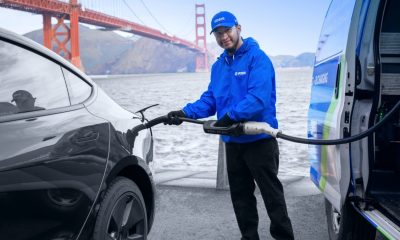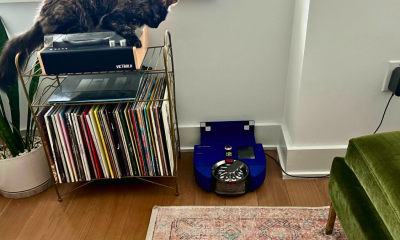Technology
LA’s new app will warn users before an earthquake strikes

As earthquake waves ripple out from a volatile fault line to the heart of a city, mere seconds of knowledge that the shakes are coming can save lives.
That’s according to the City of Los Angeles and experts who say that an earthquake early warning (EEW) system, which monitors seismic waves and notifies people when it detects that an earthquake is on the way, is a powerful way to mitigate harm.
“We’ve previously talked about earthquakes as no warning events,” Dr. Lori Peek, the director of the natural hazards center at the University of Colorado, Boulder, told Mashable over the phone. “In an earthquake, if you know what to do, and if you have a few seconds, you may be able to drop, cover, and hold on. And that really can make the difference between who lives, who is injured, and who dies.”
Luckily for “quake-prone” Southern California, Los Angeles County just became the first place in the nation to get one. On Thursday, Los Angeles Mayor Eric Garcetti announced the launch of ShakeAlertLA, an app that will send users a notification when an earthquake with a magnitude of 5.0 or greater is coming, seconds before it hits. It is the first public application of the United States Geological Survey’s (USGS) Shake Alert initiative.
“We are known together as a place that is an epicenter of seismic risk,” Mayor Garcetti said at Los Angeles City Hall Thursday. “We hope today this is another big step forward to being an epicenter of seismic preparedness.”
ShakeAlertLA became available to the public for free on December 31, and anyone can download it in the App Store or Google Play Store.

ShakeAlertLA is not the first alert system of its kind: Mexico, Japan, and several other countries already have EEW systems in place. Notably, Mexico City’s system gave residents a minute of warning before its deadly 8.1 magnitude earthquake in 2017.
With the West Coast’s vulnerability to earthquakes, the LA mayor announced his intention to join that club in 2016, setting a launch date for the end of 2018. Miraculously to some reporters in the room during the announcement, the city met the deadline — releasing the app on December 31.
The Mayor’s Fund and the Annenberg Foundation funded the creation of the app in a public-private partnership. Earthquake wave sensor technology and systems developed by the USGS, which is within the Department of the Interior, provide the underlying technology for the system. And the USGS worked with programmers from AT&T to actually develop the app. Notably, the app and notifications are completely carrier agnostic; Mayor Garcetti said the fact that AT&T won the RFP that provided the developer team has nothing to do with AT&T’s capacity as a carrier.
“It’s an app that works on everybody’s phone no matter who your carrier is,” Mayor Garcetti said.
The alert system is not an earthquake soothsayer — predicting earthquakes is still impossible. Instead, ground motion sensors placed near fault lines can detect when an earthquake is beginning, and give people who know how to read the signs a jump on the upcoming shake.
“This is not predicting earthquakes,” Dr. John Vidale, director of the Southern California Earthquake Center, told Mashable over the phone. “This is noticing the start of an earthquake using instruments, and notifying them that they’re on the way.”
Hundreds of sensors around the state, which comprise the California Integrated Seismic Network, are now monitoring the earth for signs of P-Waves. As opposed to S-Waves —the slower moving waves that actually shake the ground — P-Waves are faster, and occur sooner at the beginning of the earthquake process. So by monitoring P-Waves, sensors can tell when S-Waves are coming.

Ya got your P-waves here, ya got your S-waves there, ya got your earthquake there, and ya shake it all around.
This network of sensors was already in place before the creation of the app, but it did not previously have a public-facing application. Now, the P-wave sensors will send a signal to the ShakeAlertLA app that a P-Wave is occurring, if it indicates an earthquake with a greater than 5.0 magnitude (which means it is a significant shake).
Then, the app will send out a notification to every smartphone with the app installed that is in the affected area (currently limited to LA county) at the time. It will also send out signals to some PA systems, such as at government buildings, schools, and hospitals.
Currently, the average latency time between detection and delivery is 1.88 seconds. But even that amount of time could allow people to duck and cover, pull off to the side of the road, move away from hazardous structures, and more. Additionally, Dr. Vidale says it’s likely that as the technology improves and app use becomes more widespread, that warning time might increase.
“It may not come before the shaking for some cases, and it may not be very fast for the first year or two it’s out there,” Dr. Vidale said. “But eventually it will be very useful.”
Its usefulness could increase as EEW systems become more widespread. The app is open source, and Mayor Garcetti said he would be enthusiastic if other counties wanted to either create their own apps, using what the city’s AT&T contractors had developed, or sign on to the ShakeAlert app itself. The app also has resources to educate people about earthquake preparedness, and information about what to do in the aftermath. Additionally, the city undertook the creation of the app in concert with other earthquake preparedness measures, such as the retrofitting of buildings, pipes, and more.
Still, it’s easy to see the app’s drawbacks. The first is that it’s … an app. Who wants to download yet another app, allocating precious space to a maybe-some-day-sort-of-useful safety precaution? The mayor did not say that there would be any specific outreach campaigns to get people to download the app, beyond social media, press, and his own enthusiasm: “I’m going to certainly be talking about it,” Mayor Garcetti said.
As an app, users will also have to enable location and notification settings at all times, to receive the alerts at all. Unlike an Amber Alert or other official weather alerts that come via text message with that unmissable blaring beep, ShakeAlertLA won’t be able to catch your attention if your phone is on silent.
Finally, and perhaps most obviously, ShakeAlertLA won’t help people who don’t have smart phones — and that could negatively impact people who need earthquake warnings the most.
According to a 2018 Pew survey, 67 percent of low-income people own smartphones, as opposed to greater than 80 percent for middle income, and greater than 90 percent for high income populations. Additionally, low income and minority populations are disproportionately affected by natural disasters, according to Dr. Peek’s research, and others. With earthquakes, that is the case because those populations are most likely to inhabit the buildings and structures that are in the most dire need of retrofitting. In other words, the people who may need the warnings most may have the least access to it.
But Dr. Peek is optimistic.
“These events are really a chance to re-focus our attention on the risks that exist, that are real,” Dr. Peek said. “As long as we’re raising those questions and recognizing that the digital divide is real is when we can have those conversations.”
EEW systems like ShakeAlertLA are not a cure all. When an earthquake comes to shake things up, a few seconds can help, but it may not be enough. Making buildings and pipes earthquake resilient, doing community outreach, and getting resources and information to people who need it are the crucial supplement to early warning.
“It’s important to emphasize that this is just a limited effort,” Dr. Vidale said. “It probably will cut the earthquake losses, but it won’t eliminate them. Bad buildings will fall, infrastructure will fail, people will get hurt. This is just something to try to lessen the impact of earthquakes.”
Mayor Garcetti both recognized the challenges posed by the app, and emphasized that ShakeAlertLA was part of a larger plan of earthquake resilience. So far, the city has retrofitted 1,300 at-risk buildings, with thousands more in progress. It has also installed metal pipes, and instituted shared carrier networks in the case of an emergency.

Los Angeles Mayor Garcetti demoed ShakeAlertLA himself.
Image: Mario Tama/Getty Images
Mayor Garcetti also acknowledged that the app and its notifications are a first and imperfect step that must go hand in hand with more sensors, ways to make notifications more prominent, and increased communication between the sensors and populations that may not have smart phones.
But the Mayor and the ShakeAlertLA team didn’t want to let these issues slow them down.
“It will never be perfect, but this will give you a notification for the majority of earthquakes hitting the southland,” Mayor Garcetti said. “But while we’re waiting for a something perfect, I don’t want to wait to launch a system that can help save lives.”

-

 Business4 days ago
Business4 days agoAPI startup Noname Security nears $500M deal to sell itself to Akamai
-

 Business6 days ago
Business6 days agoYoshi Mobility has come a long way since gassing up cars on the side of the road
-

 Entertainment4 days ago
Entertainment4 days agoHow to watch ‘Argylle’: When and where is it streaming?
-

 Entertainment3 days ago
Entertainment3 days agoNASA discovered bacteria that wouldn’t die. Now it’s boosting sunscreen.
-

 Business4 days ago
Business4 days agoUS think tank Heritage Foundation hit by cyberattack
-

 Entertainment3 days ago
Entertainment3 days agoDyson 360 Vis Nav robot vacuum review: Dyson should just stick to upright vacuums
-

 Business3 days ago
Business3 days agoTesla drops prices, Meta confirms Llama 3 release, and Apple allows emulators in the App Store
-

 Entertainment4 days ago
Entertainment4 days agoCrypto and taxes: Which forms you need to file


















